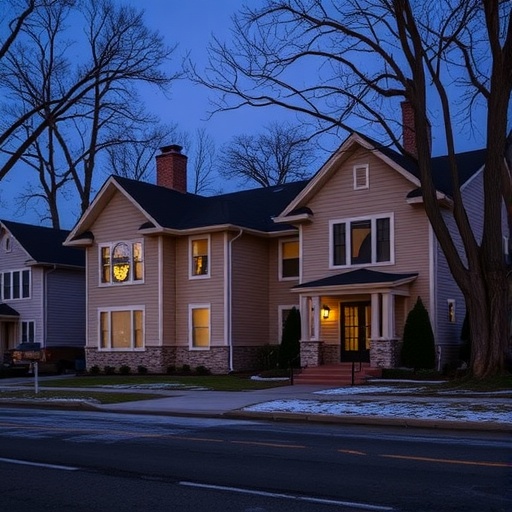US Foreclosures Surge 25% as Housing Crisis Deepens: Politicians’ Inaction Sparks Fears for 2026 Midterm Elections
In a devastating blow to American families, new federal data reveals a 25% spike in home Foreclosures nationwide over the past year, highlighting a rapidly escalating housing crisis that lawmakers in Washington are largely sidelining. As mortgage delinquencies climb and eviction notices flood communities, critics from across the political spectrum accuse both Democrats and Republicans of prioritizing partisan battles over urgent economic relief, potentially setting the stage for seismic shifts in the 2026 midterm elections.
- Foreclosure Hotspots Emerge in Sun Belt and Rust Belt States
- Bipartisan Blame Game Ignores Root Causes of Housing Woes
- Economic Fallout Threatens Broader Stability and Consumer Confidence
- Midterm Elections 2026: Housing Crisis as a Voter Flashpoint
- Path Forward: Calls for Urgent Reforms to Avert Deeper Crisis
The report, released this week by the Mortgage Bankers Association (MBA), paints a grim picture: over 300,000 foreclosure filings were initiated in the third quarter alone, up sharply from the previous year. This surge is not confined to one region; states like Florida, Texas, and Illinois are seeing the steepest increases, with low-income and minority households bearing the brunt. “We’re witnessing a perfect storm of rising interest rates, stagnant wages, and an underbuilt housing supply that’s pushing millions toward financial ruin,” said Dr. Elena Ramirez, a housing policy expert at the Urban Institute.
This crisis unfolds against a backdrop of robust national economic growth, with GDP expanding at 2.8% in the latest quarter. Yet, beneath the surface, affordability woes are eroding the American Dream. Home prices have soared 40% since 2020, according to Zillow, while the median household income has only risen by 15%. For many, the gap is insurmountable, leading to a wave of Foreclosures that could ripple through the broader economy.
Foreclosure Hotspots Emerge in Sun Belt and Rust Belt States
The foreclosures surge is hitting hardest in areas once buoyed by post-pandemic migration and economic booms, now strained by inflation and job market volatility. In Florida, where tourism and real estate drove a housing frenzy, foreclosure starts jumped 35% year-over-year. Miami-Dade County alone reported over 5,000 cases in Q3, many tied to adjustable-rate mortgages resetting at unaffordable levels.
Texas, another Sun Belt powerhouse, faces similar turmoil. Houston’s energy sector layoffs have compounded the issue, with the Texas Department of Housing and Community Affairs noting a 28% rise in delinquent loans. “Families who moved here for opportunity are now one missed paycheck from losing everything,” remarked local advocate Maria Gonzalez, founder of the Houston Homeowners Alliance.
Further north, Rust Belt states like Illinois and Ohio are reliving echoes of the 2008 financial meltdown. Chicago’s foreclosure rate has climbed 22%, disproportionately affecting Black and Latino neighborhoods. A study by the National Low Income Housing Coalition found that in Cook County, eviction filings surged 40% amid a shortage of affordable rentals. “This isn’t just numbers on a page; it’s families being torn apart,” said Rep. Chuy Garcia (D-IL), who has called for emergency federal intervention.
These regional disparities underscore a national housing crisis exacerbated by zoning restrictions and developer incentives that favor luxury builds over workforce housing. The MBA data also highlights a troubling trend: subprime loans, once curtailed post-2008, are creeping back, with origination volumes up 15% in high-risk areas.
Bipartisan Blame Game Ignores Root Causes of Housing Woes
In the halls of Congress, the housing crisis remains a low-priority issue amid debates over border security and fiscal cliffs. Critics argue that US politics is paralyzed by partisanship, with neither party offering substantive solutions. Democrats, under President Biden, have touted initiatives like the $25 billion affordable housing fund in the 2021 infrastructure bill, but implementation has been slow, with only 20% of funds disbursed by mid-2024.
Republicans, meanwhile, point to deregulation as the fix, advocating for streamlined permitting to boost supply. Yet, key GOP-led states like Florida have resisted federal aid programs, citing concerns over “big government interference.” Senate Minority Leader Mitch McConnell recently dismissed calls for a national housing task force, stating, “The private sector will sort this out without more Washington meddling.”
Independent analysts beg to differ. “Both parties are complicit in this neglect,” said Brookings Institution fellow Mark Zandi. “Democrats talk a good game on equity but fail to deliver, while Republicans block reforms that could actually build more homes. The result? A housing crisis that’s ballooning into an economic time bomb.”
Historical context reveals a pattern: the last major housing reform, the Housing and Economic Recovery Act of 2008, came only after the subprime crash devastated the economy. Today, with inflation cooling but interest rates hovering at 5.5%, experts warn of a similar tipping point. A Federal Reserve survey of economists predicts that without intervention, foreclosures could double by 2026, wiping out $500 billion in household wealth.
Grassroots voices are amplifying the frustration. In a viral op-ed in The New York Times, homeowner activist Jamal Thompson from Detroit wrote, “Politicians promise tax cuts and subsidies, but what we need is roofs over our heads. This housing crisis is a bipartisan failure that’s costing lives.” Thompson’s piece garnered over 10,000 shares, signaling growing public discontent.
Economic Fallout Threatens Broader Stability and Consumer Confidence
The ripple effects of the foreclosures surge extend far beyond individual households, posing risks to the national economy. Foreclosed properties often sell at 20-30% below market value, depressing local real estate markets and straining municipal budgets through lost property taxes. In Las Vegas, where foreclosures rose 32%, city officials report a $150 million shortfall in revenue, forcing cuts to public services.
Consumer spending, which drives 70% of US GDP, is also under pressure. A recent Conference Board survey found that 40% of homeowners are “highly concerned” about mortgage payments, leading to reduced discretionary spending on everything from cars to vacations. This caution could shave 0.5 percentage points off GDP growth in 2025, according to Moody’s Analytics.
Banks and lenders aren’t immune either. While major institutions like JPMorgan Chase have bolstered reserves, smaller community banks in foreclosure-heavy regions face heightened default risks. The FDIC reported a 15% increase in non-performing loans last quarter, echoing pre-2008 vulnerabilities.
- Job Market Strain: Foreclosure hotspots correlate with rising unemployment in construction and real estate sectors, with 50,000 jobs lost nationwide since 2023.
- Inequality Amplification: The crisis widens the wealth gap, as white households recover faster from financial setbacks than communities of color.
- Inflation Feedback Loop: Reduced housing mobility locks workers in place, exacerbating labor shortages and upward pressure on wages.
“This isn’t isolated; it’s a systemic threat to the economy,” warned former Fed Chair Janet Yellen in a recent interview. “Unchecked foreclosures could trigger a credit crunch, much like 2008, but with even less fiscal room to maneuver.”
Midterm Elections 2026: Housing Crisis as a Voter Flashpoint
As the 2026 midterm elections approach, the housing crisis is poised to become a defining issue, potentially flipping seats in vulnerable districts. Polling from Gallup shows that 62% of voters now rank housing affordability as a top concern, surpassing traditional issues like healthcare and immigration.
In swing states like Pennsylvania and Georgia, where foreclosures have spiked 25-30%, Democratic incumbents face backlash for perceived inaction on Biden’s stalled housing agenda. Republicans, too, are vulnerable; a recent Emerson College poll in Arizona revealed that 55% of independents blame GOP obstructionism for the crisis.
Emerging candidates are already pivoting. In California, Democratic challenger Sofia Alvarez has made “Housing First” her campaign mantra, proposing a $100 billion federal buyback program for distressed properties. On the GOP side, Texas Rep. Elena Vargas advocates for tax incentives to spur modular housing construction, aiming to add 2 million units by 2030.
Political strategists predict a “suburban revolt.” “Voters in exurban areas, hit hardest by this crisis, will punish incumbents who ignore it,” said Democratic consultant James Carville. “The midterm elections could see a wave of housing-focused populism, reshaping US politics for the post-Biden era.”
Nonpartisan groups like the League of Women Voters are mobilizing, with petitions for a national housing summit garnering 500,000 signatures. If unheeded, experts say, the housing crisis could fuel voter turnout not seen since 2018, with turnout projections at 65% in affected districts.
Path Forward: Calls for Urgent Reforms to Avert Deeper Crisis
Looking ahead, advocates and economists urge swift action to stem the foreclosures tide. Proposals include expanding the Homeowner Assistance Fund, which has already prevented 200,000 evictions but is set to expire next year without renewal. A coalition of 100 housing nonprofits is lobbying for its extension, alongside rent relief and down-payment assistance for first-time buyers.
On the supply side, streamlining zoning laws could unlock 1.5 million new units annually, per a Harvard Joint Center for Housing Studies report. Bipartisan bills like the Affordable Housing Credit Improvement Act, which enhances low-income housing tax credits, have stalled in committee but show promise for compromise.
The Federal Reserve’s role is also under scrutiny. With rate cuts anticipated in 2025, Chair Jerome Powell has signaled openness to targeted interventions, such as bond-buying programs for mortgage-backed securities. “We must act proactively to protect the economy from housing’s drag,” Powell stated in recent testimony.
Community-level innovations offer hope. In Minneapolis, a public-private partnership has converted foreclosed properties into co-op housing, stabilizing 1,000 units. Scalable models like this, combined with tech-driven solutions such as AI for credit counseling, could mitigate future surges.
Ultimately, addressing the housing crisis demands political will. As the nation eyes the 2026 midterm elections, the question remains: will lawmakers finally prioritize shelter over stalemate? Failure to do so risks not just more broken homes, but a fractured economy and democracy.










